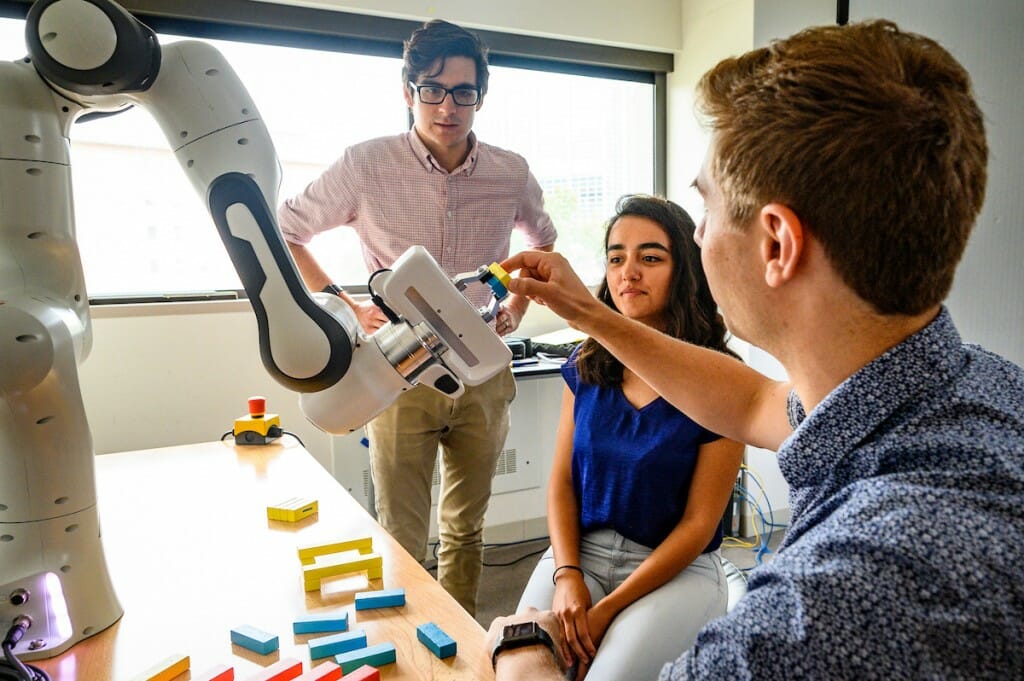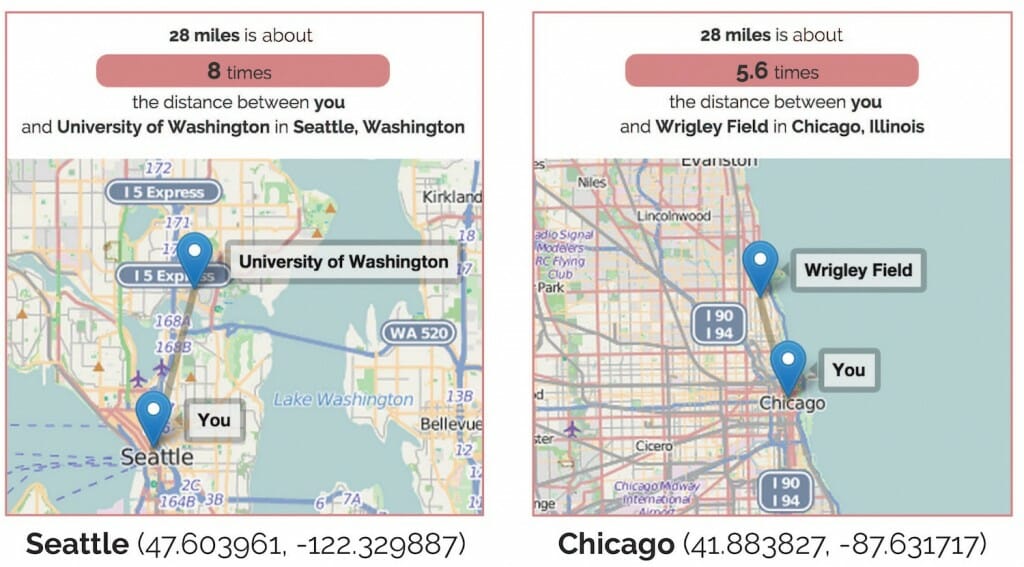Human-Computer Interaction focuses on technology to improve daily lives

Graduate students David Porfirio (left), Bengisu Cagiltay (center) and Andrew Schoen (right) work with a robotic arm in the Wisconsin Human-Computer Interaction Lab located in the Computer Science Building. Photo: Bryce Richter
From February through June, we will highlight the ways that UW–Madison powers the state’s economy through research and innovation, educates the next generation and reaches out to Wisconsinites to improve their lives. April’s theme is Innovation. Watch for more at #CantStopABadger and #UWimpact on social media. Your support can help us continue this work.
Imagine a world where workers have the ability to avoid life-threatening situations: Where a vulnerable human aerospace manufacturer once had to stand beneath the wing of a colossal aircraft, and now a robot takes their place assembling the plane. The robot extends its mechanical arms, grasping tools in one hand while doing intricate work on a hefty engine with another. Human operators stand removed from the scene, wired with sensors allowing the robot to mirror movements and safely complete what was once dangerous and backbreaking work.
At UW–Madison, this vision is becoming reality through research led by faculty in the School of Computer, Data & Information Science. In a field of research known as Human-Computer Interaction, or HCI, UW–Madison researchers are developing solutions that enable computer-based technology to improve our daily lives.
From projects involving spatially-aware robots to making life easier for those living with vision impairment, HCI research at UW–Madison aims to make technology more accessible while fostering efficiency in human-centered tasks.
Much of this research at UW–Madison is centralized in CDIS and includes faculty from the Computer Sciences Department and the Information School. Efforts were started in 2009 by Computer Sciences professor Bilge Mutlu and now include five faculty members: Mutlu and Computer Sciences professors Yea-Seul Kim and Yuhang Zhao, along with iSchool professor Jacob-Thebault Spieker and postdoctoral scholar Corey Jackson, who will join the faculty this fall.
“Any advanced, emerging technology will require a well-designed, well thought out way of interfacing with people,” Mutlu says. “HCI is critical at that juncture for effective human use and the well-being of people.”

Image courtesy of “Generating Personalized Spatial Analogies for Distances and Areas” by Kim, Hullman and Agrawala
For Mutlu, a typical day of research involves designing robotic technologies with the capacity to intimately interact with humans. A recent project with broad applications involved human-sized robots mirroring a person following a recipe. As the human poured ingredients, the robot followed along, mechanically grasping containers and completing sophisticated tasks.
According to Mutlu, the technology is being applied to modern activities such as aircraft manufacturing in collaboration with aerospace company Boeing. In that case, a similar robot is operated by a human controller, removing people from dangerous assembly situations and replacing them with a robot mimicking the human’s actions.
While Mutlu is using HCI principles in robotic technology, the field is very broad. Additional HCI research in CDIS includes diverse projects aimed at improve people’s lives by fostering accessibility in both the physical and digital world.
Yea-Seul Kim is interested in developing ways to make it easier for people to understand the data that has become increasingly pervasive in modern society. To make it easier for people to understand distance, Kim created interactive maps offering personalized reference points to help people understand the proximity of these locations. With Kim’s technology, users are better able to decipher complicated directions.
Yuhang Zhao also aims to make the world easier to navigate by creating tools to help individuals with impaired vision see aspects of daily life more clearly and navigate the physical world. In one case, she developed a cane controller that allowed blind people to experience a virtual reality, enabling blind users to navigate through virtual environments.
Information science also influences fundamental aspects of human-computer interactions, particularly those involving social implications. Corey Jackson is working to understand HCI challenges related to technology used in contact tracing.
“We’re finding that the populations most impacted by COVID-19 have the lowest adoption of these technologies,” Jackson says. “If we want to achieve higher adoption we need to ensure that our approach to the design of technology is intersectional, encompassing the voices and needs of people from all races, socioeconomic classes, and gender identities.”
Faculty members across CDIS are also focused on educating the next generation of HCI researchers and professionals. The creation of CDIS in 2019 expanded opportunities for students and faculty to explore their interests in HCI more broadly across departments.
“We can build these bridges across these different departments under CDIS to make this a strength at UW and a location for good HCI work across departments,” iSchool professor Jacob-Thebault Spieker says. “We can all benefit from these different perspectives in the HCI space.”
UW–Madison contributes $20.8 billion per year to the Wisconsin economy, and UW–Madison related start-ups contribute an additional $10 billion. Read more here.
Subscribe to Wisconsin Ideas
Want more stories of the Wisconsin Idea in action? Sign-up for our monthly e-newsletter highlighting how Badgers are taking their education and research beyond the boundaries of the classroom to improve lives.
